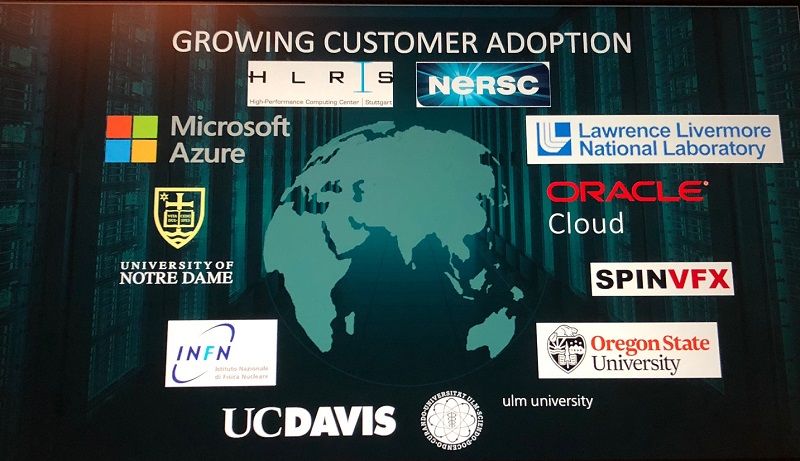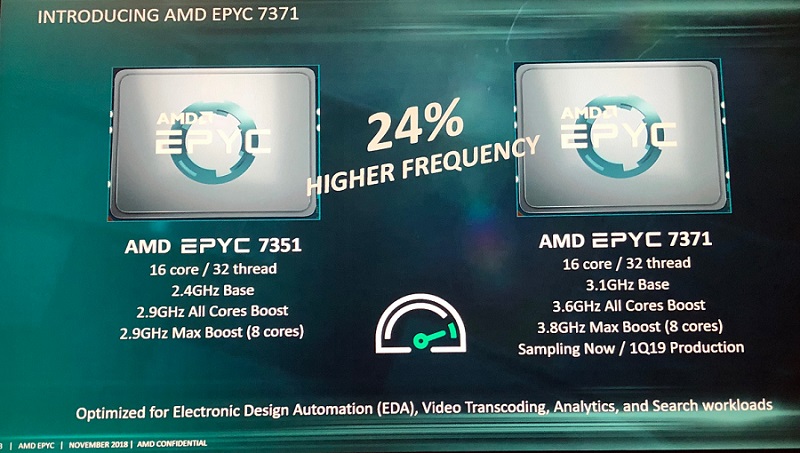It’s been a good two weeks, AMD’s Gary Silcott and Andy Parma told me on the last day of SC18 in Dallas at the restaurant where we met to discuss their show news and recent successes.
Heck, it’s been a good year. AMD Epyc, delivered to the market earlier this year, has been winning – convincingly winning – the price/performance bake-off against Xeon. Wall Street has fallen in love with AMD stock (though with some slackening of late). And the company moved off the market share dime for high end server chips; in fact, AMD stands by its expectation of hitting the “mid-single digits” for market share by the end of the year. And we’re seeing Epyc pop up in some major systems wins, such as HPE’s announcement at SC18 that it will deliver the fastest supercomputer in the world for industrial production, an Epyc-powered system (more on that below).
There’s no arguing: AMD has shined in 2018. But it still has a hill to climb after backing out of the datacenter server processor and HPC markets over the last half-decade or so.
AMD will tell you the company dropped out of those markets for a server processor re-set, the result of which is Epyc. All well and good, but there’s a price to pay for a market drop out: a credibility hit. When you ask managers of IT organizations and HPC centers to bet against Intel, you’re asking them to take a risk. Now, with a processor technology buyers can love, trust remains the missing piece.
This is why everyone at AMD, starting with Lisa Su, is laser focused on executing the AMD roadmap and touting that execution to anyone who’ll listen. AMD believes hitting milestones not only reestablishes credibility, it stands in contrast to the market leader, which has had significant roadmap making challenges over the past 12 months.
“We set out to hit our milestones and deliver to our customers and we did it,” the CEO stated in her keynote at the AMD Next Horizon event in San Francisco last week (Nov. 6). Yes, that was the week leading into SC18 – it’s been a busy time for AMD and the reporters who cover them.
Putting the next-gen Eypc and Radeon GPU launch the week before the biggest HPC conference of the year gave AMD a strong hand coming into SC18. With up to 64-Zen2 cores, the 7nm Rome chip provides at least two times higher performance per core than first-generation Epyc chips. The revamped Radeon Instinct line, the MI60 and MI50, are the world’s first 7nm datacenter GPUs, and feature flexible mixed mixed-precision capabilities. Both families support PCIe gen4.
Traction for all three generations of Epyc (Naples, Rome and future-gen Milan) got a shot in the arm in the last few weeks, with four five major system wins showcasing AMD’s growing traction as well as the diversity of its partners and end users. [Editor’s note: article has been updated to include Finland’s next-gen system.]
 In late October: the DOE in tandem with Berkeley Lab revealed Perlmutter (code-name: NERSC-9) would be built by Cray on its next-gen Shasta architecture with future generation Epycs (Milan) plus future-generation Nvidia GPUs. Perlmutter, due out in 2020 with a planned 100 petaflops (peak) performance, will put AMD solidly back on the leadership supercomputing map, a position it hasn’t enjoyed since the circa-2012 NCSA Blue Waters supercomputer, which is set to retire next year after getting a one-year reprieve (sys admins are currently ferrying data from Blue Waters to Frontera, the next NSF tier 1 system, deployed at TACC).
In late October: the DOE in tandem with Berkeley Lab revealed Perlmutter (code-name: NERSC-9) would be built by Cray on its next-gen Shasta architecture with future generation Epycs (Milan) plus future-generation Nvidia GPUs. Perlmutter, due out in 2020 with a planned 100 petaflops (peak) performance, will put AMD solidly back on the leadership supercomputing map, a position it hasn’t enjoyed since the circa-2012 NCSA Blue Waters supercomputer, which is set to retire next year after getting a one-year reprieve (sys admins are currently ferrying data from Blue Waters to Frontera, the next NSF tier 1 system, deployed at TACC).
The High-Performance Computing Center of the University of Stuttgart (HLRS) revealed at SC that it is using the next generation AMD Eypc Rome processor to power what is anticipated to be the largest supercomputer in Europe and the world’s fastest supercomputer for industrial production. That system, named Hawk, will be built by HPE and will have a theoretical peak performance of 24 petaflops and consist of a 5,000-node cluster. It is set to debut in 2019.
Lawrence Livermore has signed on with system-builder Penguin Computing for an all AMD heterogeneous machine, what AMD calls A+A. That system, named Corona, will have 170 nodes incorporating more than 300 AMD Eypc 7401 processors and 300 AMD Radeon Instinct MI25 GPUs. With these current gen technologies, Corona will be delivered soon and is expected to come online for limited use by the end of the year. Lawrence Livermore reports that the unclassified computing cluster will provide unique capabilities for lab researchers and industry partners to explore data science, machine learning and big data analytics.
On Tuesday (Nov. 13) the Finnish IT Center for Science Ltd (CSC) announced that it had selected AMD future-gen Rome Epycs to power the second phase of its next-generation supercomputer and data management systems, to be supplied by Atos. The planned system, due to come online in spring 2020, will be comprised of BullSequana XH2000 servers with Rome processors and Mellanox HDR InfiniBand, plus tightly integrated storage. The phase 2 partition will extend the compute capacity of the phase one Intel Xeon Cascade Lake-equipped system, expected to be available to CSC researchers in summer 2019. CSC is the first customer of Atos’ BullSequana XH2000, which was launched on Monday at SC18.
 Moving back over to the commercial sector, the F1 HAAS racing team has deployed current generation 7000-series Epyc processors as part of a Cray CS500 cluster that it will use for CFD simulation. “The combination of the system’s design and ability to handle the most demanding simulation and analytics workloads and the high-performance computing expertise of Cray helps the Haas F1 team optimize aerodynamics and more accurately predict and reduce drag, downforce and flow patterns around its race cars,” said Cray.
Moving back over to the commercial sector, the F1 HAAS racing team has deployed current generation 7000-series Epyc processors as part of a Cray CS500 cluster that it will use for CFD simulation. “The combination of the system’s design and ability to handle the most demanding simulation and analytics workloads and the high-performance computing expertise of Cray helps the Haas F1 team optimize aerodynamics and more accurately predict and reduce drag, downforce and flow patterns around its race cars,” said Cray.
In addition, the University of Notre Dame Center for Research Computing, Oregon State University and the National Institute for Nuclear Physics in Italy have all also deployed AMD Epyc-based systems.
“One of the questions we got asked this week,” said Parma, Epyc HPC product/segment marketing leader at AMD, “was ‘do you have a favorite customer, favorite preferred customer?’ The answer is no, right now we are having a lot of success with a lot of different customers which is a great place to be right now.”
 Other highlights from AMD announced this week include:
Other highlights from AMD announced this week include:
- A preview of a new HB instance debuted on Microsoft Azure this week. HB VMs feature 60 AMD Epyc 7551 processor cores, 4 GB of RAM per CPU core, and no hyperthreading, according to Microsoft.
- High-Frequency Epyc processor — The new AMD Epyc 7371 processor, introduced this week, was designed for workloads such as EDA and high-frequency trading. The new SKU is on track for production availability in the first quarter of 2019
- ROCm 2.0 Open Software Platform— AMD also showcased the newest version of AMD ROCm, designed for scale and HPC, energy-efficient heterogeneous computing systems in an open environment.
Reached for comment, HPC market watcher Addison Snell, CEO of Intersect360 Research said, “We see a lot of potential interest in AMD Epyc in the HPC arena, at a time when many organizations are ready to reevaluate what architectures they build on moving forward. AMD offers a compelling x86 option to Intel. With little to lose, it’s not really a question of whether AMD will gain share, but rather how much share they’ll gain.”
Company leaders, though, are not taking any chances and continue to emphasize AMD’s commitment, dedication and follow-through.
“Focus, execution and delivery — that’s what makes AMD a bankable supplier,” said Mark Papermaster, chief technology officer and senior vice president of technology and engineering, in his keynote address at AMD’s media and analyst event on Nov. 6. ”When we make the effort to go back into high performance, equally important with coming out with that first set of products in 2017 was the roadmap behind it because that’s what enterprise customers need. They want to know that you are delivering value today and they need full confidence in the roadmap going forward. That’s what we are doing that’s a game changer for AMD and for riding the acceptance of these new products in the market.”
Doug Black contributed to this report.





























































